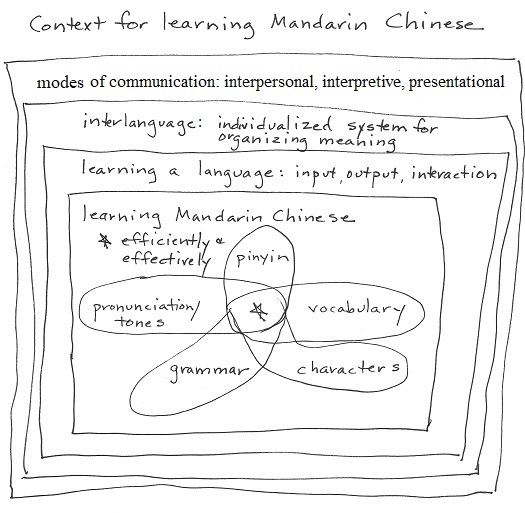The protocol described on this page is an attempt to synthesize the findings of research on second language acquisition, learning, memory, neuroscience, and psychology to derive a systematic, research-informed prototype of a protocol by which adults can learn Mandarin Chinese optimally. In this case, “optimally” is defined as achieving desired outcomes as efficiently as possible, with as little time, effort, and expense as possible.
According to Everson et al., 2016, “For native readers of modern Chinese, it is estimated that between 2,000 to 3,000 characters are needed to accomplish most reading functions on a daily basis. Chinese children learn 3,500 characters from first to ninth grade.”
Among the acquisition difficulty rankings of languages by the U.S. Department of State, Mandarin Chinese is ranked as a Category IV language, among the very hardest to learn. Since now might be a very important time for adults to learn to speak Mandarin Chinese, how might we address these difficulties?
The intended outcomes of the protocol are to assist adult learners of Mandarin Chinese to efficiently achieve a level of proficiency such that they can effectively communicate with other speakers of Chinese about feelings, thoughts, and ideas, as well as about living, “liking,” loving, and working. Perhaps, through ably speaking about inner and outer experiences, we may achieve some level of mutual understanding, and perhaps contribute, at some level, to world peace.
At essence, the purpose of research on human endeavors is to determine what works for most people, most of the time, better than other things, and better than nothing.
Research suggests that to increase the efficiency and effectiveness with which adults might learn Mandarin Chinese, the five major language learning components of Mandarin Chinese – 1) pronunciation, including tones, 2) pinyin, 3) vocabulary, 4) grammar, and 5) characters – would be engaged in simultaneously and synergistically through consciously selected mechanisms of input, output, and interaction, within a consciously envisioned interlanguage for organizing the components of language – listening, speaking, reading, and writing.
Adult learning of Mandarin Chinese is hypothesized to be optimized by engaging in a sort of “flow” in, around, and through all the components, rather than using a task-focused approach and attempting to address one component at a time.
An additional hypothesis of the protocol is that native English-speaking adults – including older adults – can adequately learn second languages online – in near isolation, in the presence of a pandemic, in the absence of immersion – and would do so in systems rather than in components.
Plain language definitions of terms
- Input. Any and all exposure to language. Optimized by presence in a language-speaking country and/or voluntary reading.
- Output. Creation of spoken and written content to communicate rather than to complete tasks, i.e. content created “for real purposes.”
- Interaction. Opportunities to speak, and build, conversations. Note: The value of interaction is influenced by the nature of corrective feedback given. Corrective feedback that increases anxiety decreases acquisition. Learner anxiety is a known barrier to language acquisition.
- Interlanguage. One’s own “interlanguage” is an individualized, systematic way to organize second language information, make meaning from it, and produce speaking and other language “output.”
- Pinyin is the romanization of the pronunciation of Chinese characters. Tones are integral components of pronunciation. Characters combine together to form vocabulary. Grammar indicates how to make correct sentences.

More about an “interlanguage”
Based on my reviews of the research literature, the primary way adults can optimize their second language learning is through consciously developing an inner system of making meaning of the content of the language. This is termed an “interlanguage.”
An “interlanguage” is a developmental, dynamic, individualized, systematic way to use the brain’s schematic functions to organize second language information, make meaning from it, and speak, write, and create in it. If the learner continues to be willing to receive input, the interlanguage can eventually transform into bilingualism, i.e. the person is able to think, feel, work, relate, and make decisions in both languages.
According to Gass et al. in Second Language Acquisition, an interlanguage is a means “both consistent and dynamic,” by which “learners themselves impose structure on the available linguistic data and formulate an internalized system.” Further, consciousness of an interlanguage may protect against “fossilization,” a language learner’s creation of over-strong schema and too-early cessation of learning in some areas.
In contrast to learning languages as components – vocabulary, grammar points, pronunciation, etc. – having an inner vision of how one creates a dynamic, interrelated, patterned, structured network for learning a second language may optimize use of the brain’s schematic functions and increase the efficiency of learning.
This, I believe, is a real-world example of an interlanguage at work:
“Renée Fleming spent two years in Germany studying voice while she was in her twenties. She told me that over the course of her life, each time she went back to Germany she found her fluency had mysteriously improved, as if the language had continued to work its way into her brain regardless of whether she was speaking it.”
– Ann Patchett, “These Precious Days“
Optimizing the learning of Mandarin Chinese
From the synthesis of research from which the learning protocol is being derived, these suggestions arise. They are written in “you-statements” to address the learner.
Self-kindness optimizes. Contrary to popular belief and practice, pressure to work harder, to do more, and to do better – and criticism if one falls short – actually decreases learning. Instead, a sense of kind, existential acknowledgement and acceptance creates capaciousness for learning. Consider shining the sun of self-kindness on your mind and heart and your brain’s ability to learn.
Having a conception of one’s own interlanguage may optimize. In contrast to learning languages as components – vocabulary, grammar points, pronunciation, etc. – having an inner vision of how you are creating an interlanguage may increase the efficiency of learning. Using metaphors or analogies to describe your interlanguage may be helpful. Sketching it may be helpful as well. Asking about new content, “Where does that fit?” may foster integration of content into one’s interlanguage.
Developing an interlanguage may be related to what is termed an “advance organizer,” a research-suggested method for orienting students to second language learning that optimizes outcomes, particularly with regard to vocabulary.
Interaction optimizes. According to neuroscience studies on second language learning, adults learn languages most efficiently through social interaction, particularly when it’s immersive for adult learners.
The optimal way for the brain to receive language input and to generate language output is through immersive interaction and experience of all aspects of a language, i.e. listening, speaking, reading, and writing. Formal instruction assists with organizing language information into an accurate interlanguage. The more individuals can create an interaction-rich, instruction-rich environment for themselves, the more efficient and effective their learning is likely to be.
When teachers – either by training or intuition – understand the theories of shaping, comprehensible input, comprehensible output, Total Physical Response (TPR), the forgetting curve, and “quick wins,” and conduct their classes primarily in Mandarin Chinese, second language learning may be optimized. Paradoxically, interruptions using the mother tongue may interfere with the brain’s construction of an interlanguage, its inner network of understanding and meaning.
Personally meaningful input and output optimizes. Attempt to listen, speak, read, and write in ways that are personally important to you and align with your needs, wants, strengths, interests, values and priorities. Benefits may abound from extensive listening and reading.
Using brain science optimizes. The primary brain functions used for second language learning are attention and memory. Attention uses brain structures and functions that need replenishment. Acknowledge directed attention fatigue and allow quiescent time for the brain to create its interlanguage. Research suggests that attempting to engage in learning that requires sustained focus for 50-minute intervals is optimal. Then, engage in attention-resting activities to restore the brain’s “supply” of attention. Use awareness and experimentation to find the optimal learning schedule to optimize second language acquisition with your own beautiful, complex brain.
Feedback optimizes. Ask teachers and peers for supportive, specific, frequent feedback, both informal and formal. Consider formal assessments. Consider training for a test, such as the HSK exams.
Multiple exposures in multiple contexts are usually required for learning new content. Researchers have found that second language learners may need from 3 to 17 exposures to learn a new word. Approach each learning event with kindness and curiosity, and as an opportunity to accumulate exposures, rather than insisting it be the definitive event whereby the content is learned absolutely and permanently. Multiple and varied exposures to the same content enhances learning more than does a repeated method with the same content. A multiple-exposures approach fosters delight and reduces judgment. Self-judgment increases anxiety which reduces learning.
Prioritize precise pronunciation. Mandarin Chinese is a precisely pronounced language. In English, often “good enough will do.” In English, the meaning of mispronounced words can usually be discerned. In Mandarin Chinese, an attempt to create “good enough” may be unintelligible, even rude. To be understood and to understand – the essence of communication – pronunciation has to be exact.
Discover the optimal time to learn to read. When you learn enough pinyin, pronunciation, tones, and vocabulary to have trouble distinguishing the sound of one word’s meaning from another, this is the time to learn to read. Since spoken Mandarin Chinese only contains 400+ syllables, and 4 tones + a neutral tone, many words sound alike, although the majority of characters representing the sounds are distinct. Having an interior mental, visual image of the character that corresponds with the syllable can offer “disambiguation,” i.e. the ability to differentiate sounds and meanings from each other.
Consider graded readers. As defined by Mandarin Companion, “Graded readers are books created specifically for foreign language learners that are written using carefully controlled words and grammar.” From Mandarin Companion, here’s more about the role and function of graded readers.
Create your own content and discuss it with others. Using one’s interlanguage to generate pieces of writing – from autobiographical sentences, to expository paragraphs, to questions to ask ones teachers and peers, to fiction and poetry – then reading these pieces aloud and asking others to read them aloud, expressing your ideas about them, and listening to the ideas of others, calls forth a glorious, individual integration of what research suggests optimizes second language acquisition: use of previous input, organized in one’s interlanguage, to generate personally meaningful output with which to interact and communicate.
(I hypothesize that, through writing, adults can most efficiently develop an interlanguage. This is a hypothesis, informed by research, but not verified by it. Here is an example of an exercise designed to maximize the power of writing to optimize learning.)
Acknowledgements
Early contributors to the derivation of this protocol include Depeng Li, Jun Xu, Benfang Wang, and Letty Wang-Moore. Cornelius C. Kubler, Ph.D. responded to questions about learning Mandarin Chinese online during a pandemic. Susan Gass, Ph.D., responded to questions about second language learning in older adults. John Pasden responded to multiple questions.
A course for older adult learners is proposed as part of a larger attempt to synthesize the research on learning, psychology, and neuroscience and to derive a systematic, research-based protocol – and engage in it at the same time – to, as an English-speaking older adult, learn Mandarin Chinese efficiently and effectively.
. . . . .
This protocol is a work in progress. The content of this page was last updated 5/9/22. The present review was not intended to provide exhaustive coverage of all research pertaining to the topic.
I welcome expert consultation and scientific inquiry. Please contact Anne Giles.
Photo of Depeng, italki instructor
Note: Anne Giles, M.A., M.S., L.P.C. is a beginning student of Mandarin Chinese and also a counselor, able to provide counseling services only to residents of Virginia, U.S.A. This content is for informational purposes only and is not a substitute for medical or professional advice. Consult a qualified health care professional for personalized medical and professional advice.


